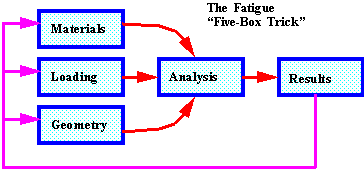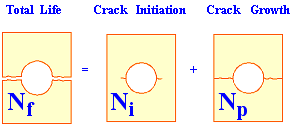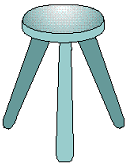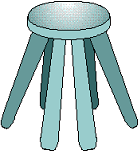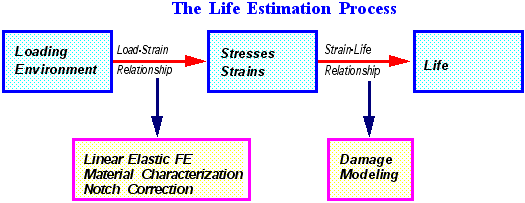XXXXXXXXXXXXXXXXXXXXXXXXXXXXXXXXXXXXXXXXXXXXXXXXXXXXXXXXXXXXXXXXXXXXXXXXXXXXXXXXXXXXXXXXXXXXXXXXXXXXXXXXXXXXXXXXXXXXXXXXXXXXXXXXXXXXXXXXXXXXXXXXXXXXXXXX''"> Definitions
The first concept to understand before embarking on this tutorial is the definition of the term fatigue within the confines of this guide. Very often the terms fatigue, fracture, and durability are used interchangeably. Each does, however, convey a specific meaning.
Note: | Throughout this manual, when a new term or concept is introduced or mentioned for the first time, it is highlighted in blue italics. This means that a definition is provided in Glossary of Terms. |
What is Fatigue?
Although many definitions can be applied to the word, for the purposes of this manual, fatigue is failure under a repeated or otherwise varying load which never reaches a level sufficient to cause failure in a single application.
It can also be thought of as the initiation and growth of a crack, or growth from a pre-existing defect, until it reaches a critical size, such as separation into two or more parts.
Fatigue analysis itself usually refers to one of two methodologies: either the stress-life or S-N method, commonly referred to as total life since it makes no distinction between initiating or growing a crack, or the local strain or strain-life (ε-N) method, commonly referred to as the crack initiation method which concerns itself only with the initiation of a crack.
Fracture specifically concerns itself with the growth or propagation of a crack once it has initiated.
Durability is then the conglomeration of all aspects that affect the life of a product and usually involves much more than just fatigue and fracture, but also loading conditions, environmental concerns, material characterizations, and testing simulations to name a few. A true product durability program in an organization takes all of these aspects (and more) into consideration.
Note: | Fatigue cracks initiate and grow as a result of cyclic plastic deformation. Without plasticity there can be no fatigue failure. All attempts are made in this guide to explain how plasticity is taken into account when determining fatigue life from linear elastic finite element analysis. |
The Fatigue “Five-Box Trick”
Almost without exception, each exercise is constructed around the concept of the fatigue “five-box trick.” The illustration to the right depicts this well. For any life analysis whether it be fatigue or fracture there are always three inputs. The first three boxes are these inputs:
1. Cyclic Material Information: Materials behave differently when they are subject to cyclic as opposed to monotonic loading. Monotonic material properties are the result of material tests where the load is steadily increased until the test coupon breaks. Cyclic material parameters are obtained from material tests where the loading is reversed and cycled until failure at various load levels. These parameters differ depending on the fatigue analysis type involved.
2. Service Loading Information: The proper specification of the variation of the loading is extremely important to achieve an accurate fatigue life prediction. The loading can be defined in various manners. Whether it be time based, frequency based, or in the form of some sort of spectra depends on the fatigue analysis type to be used. When working with finite element models the loading can be force, pressure, temperature, displacement, or a number of other types. Loading in the test world usually refers to the acquisition of a response measurement, usually from a strain gauge.
3. Geometry Information: Geometry has different meanings depending on whether you are working from a finite element model or from a test specimen. In the testing world, the geometry input is the Kt (stress concentration factor) since the point of failure is usually away from the actual point of measurement. Therefore a geometry compensation factor (Kt) is defined to relate the measured response to that at the failure location. You can think of this as a fudge factor. With a finite element model the local stresses and strains are known at all locations (Kt=1 at all locations). The FE geometry gives us the entire stress distribution needed for fatigue life calculations. For crack growth analysis the geometry definition takes on yet another form as a compliance function.
The correctness and accuracy of each of these inputs is important in that any error in any of these will be magnified through the fatigue analysis procedure, the fourth box, since this process is logarithmic. A ten percent error in loading magnitude could result in a 100% error in the predicted fatigue life.
Do not worry too much about this, because the fifth box is the postprocessing or results evaluation. This can take on the form of color contours on a finite element model or a tabular listing but also quite often leads back into the three inputs to see what effect variations of these inputs will have on the life prediction. This is referred to as a sensitivity or a “what if” study. This is extremely useful at times when you are not quite sure about the accuracy of one of the inputs. The software denotes this as “optimization” in places.
Life Prediction Methods
MSC Fatigue uses three life prediction methods as already mentioned earlier. These are total life, crack initiation, and crack propagation. Total life is aptly named in that only the total life of the component is of concern and not when a crack will initiate or how quickly it will grow.
The three methods are related to each other by the fact that the total number of cycles to failure, Nf, equals the number of cycles to initiate a crack, Ni, plus the number of cycles to propagate that crack, Np. The three methods have grown out of different needs over the decades using different techniques and having different degrees of accuracy. So in theory this equation is true, but in practice when applying the three methods to the same problem, rarely, if ever does it add up.
In reality however, rarely are all three methods used on the same problem, mainly because different industries adopt different analysis methods depending on the driving design philosophy. See
Design Philosophies.
FE Analysis Methods
In addition to the three life prediction methods, MSC Fatigue also supports use of these methods using stress/strain response results from different finite element analysis techniques. The table below summarizes which FE analysis types are applicable to which life prediction methods in this release of the software.
Table 1‑1 Life Prediction Methods versus FE Analysis ResultsTotal Life | Crack Initiation | Crack Growth |
Linear Static | Linear Static | Linear Static |
Linear Transient | Linear Transient | Linear Transient |
Frequency Response | | |
Random Vibration | | |
Design Philosophies
There are three main fatigue design philosophies. Each centers around one of the fatigue life estimation methodologies. To illustrate the three consider the design of a stool.
Safe Life
The safe life philosophy is a philosophy adopted by many, but especially the ground vehicle industry. Products are designed to survive a specific design life. Full scale tests are usually carried out with margins of safety applied. In general, this philosophy results in fairly optimized structures such as a stool with three legs. Any less than three legs and it would fall over. This philosophy adopts the crack initiation method and is used on parts and components that are relatively easy and inexpensive to replace and not life threatening if failure were to occur. Most of the life is taken up in the initiation of a crack. The propagation of that crack is very rapid and short in comparison.
Fail Safe
On the other end of the spectrum of design philosophies is that of fail safe. This is where a failure must be avoided at all costs. And if the structure were to fail it must fall into a state such that it would survive until repairs could be made. This is illustrated with our stool now having six legs. If one leg were to fail, the stool would remain standing until repairs could be made. This philosophy is heavily used in safety critical items such as in the aerospace or offshore industries.
Damage Tolerant
The middle ground philosophy is that of damage tolerance. This philosophy, adopted heavily in the aerospace community and nuclear power generation, relies on the assumption that a flaw already exists and that a periodic inspection schedule will be set up to ensure that the crack does not propagate to a critical state between inspection periods. As implied, this philosophy adopts the crack growth method. This is illustrated using our stool (now with four legs) but with someone inspect it instead.
This particular design philosophy is generally used in conjunction with the fail safe philosophy, first to design for no failure. and then to assume that, for whatever reason, a flaw exists and must be monitored.
Life Estimation Process
The life estimation process really centers around two major relationships.
1. The first relation is that of the loading environment to the stresses and strains in the component or model. This load-strain or load-stress relation is determined using finite element modeling and running linear elastic FE analysis. It is dependent on the characterization of the material properties and in some instances requires that a notch correction procedure take place. For the purposes of this discussion a notch correction is simply a way to compensate for plasticity from a linear FE analysis.
2. The second relation is that of the stresses or stains to the life of the component or model. This is accomplished by using damage modeling. Each fatigue life method has its own techniques to determine and sum damage which shall be explained as you progress through the example problems.
Note: | All example problems were created on the Windows platform as well as all graphical dumps of screen shots. The graphics may appear slightly differently on UNIX platforms; however, all operations are identical unless specified otherwise. In some situations, you may need to double-click the mouse on the Windows platform whereas on UNIX, a single-click performs the operation. |
